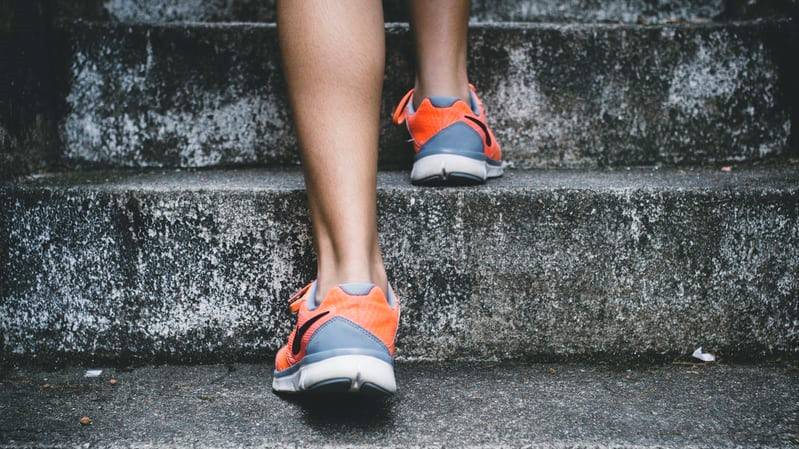Although overuse injuries are probably the most common triathlon injuries, other injuries can also occur. One of the most common injuries in sports is torn ligaments in the ankle. Although this can often be found in contact sports, it also occurs again and again in triathlon, since even unfavorable appearance can lead to injury.
anatomy
The ligaments are the connection between the foot and lower leg and are a supporting and flexible element of the ankle. This is where the outer ligaments are particularly vulnerable and even normal twisting can lead to strains, overstretching or tears. The inner ligaments are affected less frequently.
causes
In jumping sports such as basketball, handball and volleyball, an uncontrolled landing often leads to a tear. The foot buckles under high stress, which the ligaments can no longer prevent. In triathlon, the unfortunate twisting of the ankle is often a cause, but some of the injuries are also self-inflicted. Bad warm-up, running on bad, wet or unclear terrain, unsuitable shoes or too intensive training when tired are common triggers, but also avoidable. That's why you always make sure during training that you don't have to accept an injury due to carelessness or laziness. In the transition zones, when swimming out or when hectic getting on and off the bike, your head is often somewhere else than when you are running cleanly, but it is particularly important to be attentive here, as it would be very annoying to drop out of the competition due to an avoidable injury .
Initial treatment and diagnosis
If you do twist your ankle, you can follow the LUCKY rule. That stands for
pause , hold ice to joint for cooling, compression and elevation . The degree of pain and swelling will indicate whether a visit to the doctor is necessary. There, a mobility test (e.g. drawer test) is usually used to differentiate between fracture, tear and strain. An X-ray can also rule out a fracture, but some doctors still use a held image, in which the foot is placed in a clamping device to measure the joint gap angle. This method can cause further tissue damage and a competent physician should be able to detect a tear without an X-ray.
Ligament tear - treatment
There are three ligaments in the ankle, the front one being the most likely to tear and the back one the least likely to tear. The capsule of the joint can also be affected by tears, which leads to the classic swelling and discoloration. Cracks cannot be detected, for example, by the above-mentioned recording. A cast is rarely necessary for a torn ligament, as a splint/orthosis is better suited for mobility and simultaneous support of the joint. Muscle atrophy is also less with the splint. Surgery is only necessary in the case of really severe trauma or chronic instability of the joint. The rest period is around 6 weeks.
training entry
However, a rest period should not (only) be understood to mean simply putting your foot up. As soon as the swelling has gone down, you can start with light exercise so that the muscles don't atrophy. However, when moving, stability of the joint should be ensured and light strengthening exercises, walking and cycling are also fine. Physiotherapy is also highly recommended (even if you have to finance some of it yourself). Good healing and the restoration and improvement of joint stability are essential for further sports careers, since chronic instability can occur without continuous training. The 6 weeks of healing should then be followed by about 6 weeks of build-up training, since the joints first have to get used to the triathlon load again. Slight pain at the beginning of the training is unfortunately normal (but if the pain is more severe, the training should be reduced or paused and a physiotherapist should be consulted again), especially when kicking the leg and pulling on the crank. The scope and intensity of training should initially be increased slowly and in consultation with a doctor or physiotherapist.
prophylaxis
Because joints and ligaments return to their initial levels very slowly (if at all) after an injury, care should be taken to reduce the risk of re-injury as much as possible. It helps to use the right footwear for each run, warm up thoroughly, take fatigue seriously and not overstrain, and strengthen the joints and surrounding muscles. The focus should be on strengthening the shin muscles and stretching the calf muscles, but proprioceptive training is also important. The intramuscular and intermuscular coordination is strengthened through coordinative exercises on the wobble board, the slackline or the therapy spinning top, which leads to better cooperation and faster reaction times of the muscles. By the way, walking barefoot has similar effects.
Exercises to strengthen the ankle
Toe Stand: Alternately stand on your tiptoes and let them down again, or hold them up. Performing on uneven ground improves coordination.
Alternating step: Stand alternately on toes and heels.
Stork step: Take long and slow steps while pushing off vigorously with the tips of your toes and landing on them.
Shin muscles: Pull your toes up against resistance from the Theraband or partner.
Hopping: Both or one leg possible, but only in advanced recovery.
Running ABC: All exercises are useful here. Only perform jumping exercises after the injury has healed. Foot ABC: alternately walk on toes, outside edge, inside edge or on the heel




















